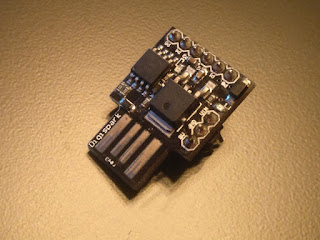Estimating the characteristics of counterfeit MOSFETs.
I needed some MOSFETs for a four channel constant current load but didn't have any besides some counterfeit IRL3803 MOSFETs I had received from aliexpress. I mean these are still MOSFETs inside, just very small ones. For my load I need something that can handle 1A and max ~5W dissipation, so let's take a look at the silicon die and see whether these will work or not. The method described is only good for a rough estimate, but at least allows you to make use of the MOSFETs instead of tossing them away.
First I need to crack one open, which I already did when filing a refund, so that's done. I also need a genuine MOSFET as reference, that we'll use to extrapolate the approximate characteristics of the counterfeit MOSFET. For this I chose a blown NTD70N03R.
I used this website to take the measurements: https://eleif.net/photo_measure.html
The area on the fake IRL3803 die is abut 1.45sqmm and the area on the NTD70N03R is about 6.6sqmm, which makes the fake IRL3803 die about 4.55 times smaller, this is the key number you need to extrapolate the approximate characteristics of a MOSFET.
First let's calculate the approximate power dissipation for the die. For this we take the max power dissipation of the NTD70N03R, which is 62.5W and divide it by 4.55, which results in about 13.7W max power dissipation for the tiny die in the fake IRL3803.
Next we calculate the current. The max drain current that the die in the NTD70N03R can handle is 72A, so we divide that by 4.55 and get about 15.8A max continuous drain current that the silicon die in the counterfeit MOSFET can handle. But what about the bondwires? It's hard to measure the bond wires so let's assume that they scale with the silicon. This would mean that the 32A that the bond wires in the NTD70N03R can handle gets divided by 4.55 and results in approximately 7A max continuous that the bond wires in the fake IRL3803 should handle. Not that bad so far.
Next we take a look at the RDSON. On the NTD70N03R the ON resistance is 5.6mOhms and if we multiply this by 4.55 we get about 25.5mOhms of ON resistance for the counterfeit MOSFET.
This is about as much as we can estimate from the size of the die. Such things as gate threshold voltage, gate capacitance, VGSmax or VDSmax would need to be measured with test gear since we can't estimate them just by looks. But now that we know the approximate parameters we can find analogous MOSFETs and perhaps use them as reference. The die used in these counterfeit MOSFETs had to come from some other lower power MOSFET so knowing these parameters may even lead to finding that particular MOSFET.
But let's get back to the original question. Will these MOSFETs work for my constant current load? The answer is yes. There is quite a large margin for error so I can safely assume that I'll have no problems using these MOSFETs for my constant current load. As a matter of fact I've already built the load and it's been working perfectly fine as a part of another project as you'll no doubt see in a future post.
That's all for now, thanks for visiting my blog.




Komentarai
Rašyti komentarą